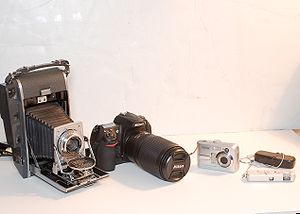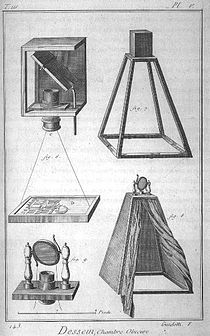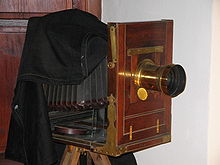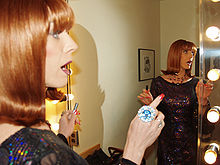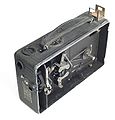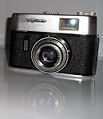- Camera
-
A camera is a device that records and stores images. These images may be still photographs or moving images such as videos or movies. The term camera comes from the camera obscura (Latin for "dark chamber"), an early mechanism for projecting images. The modern camera evolved from the camera obscura.
Cameras may work with the light of the visible spectrum or with other portions of the electromagnetic spectrum. A camera generally consists of an enclosed hollow with an opening (aperture) at one end for light to enter, and a recording or viewing surface for capturing the light at the other end. A majority of cameras have a lens positioned in front of the camera's opening to gather the incoming light and focus all or part of the image on the recording surface. The diameter of the aperture is often controlled by a diaphragm mechanism, but some cameras have a fixed-size aperture. Most 20th century cameras used photographic film as a recording surface, while the majority of new ones now use an electronic image sensor.
The still camera takes one photo each time the user presses the shutter button. A typical movie camera continuously takes 24 film frames per second as long as the user holds down the shutter button, or until the shutter button is pressed a second time.
From its inception, the camera has been instrumental in the recording of still images from then-present surroundings, and further modifications led to the development of motion picture sequences in the late 19th century. Cameras and the exhibition of camera-captured images are widely used in both professional and consumer settings in the 21st century for both mass and interpersonal communication purposes.
Contents
History
The forerunner to the photographic camera was the camera obscura,[1] a Latin name literally meaning a dark room but more generally "...a darkened chamber or box, into which light is admitted through a pinhole (later a convex lens), forming an image of external objects on a surface of paper or glass, etc., placed at the focus of the lens".[2] In the 6th century, Greek mathematician and architect Anthemius of Tralles used a type of camera obscura in his experiments.[3] The camera obscura was described by the Arabic scientist Ibn al-Haytham (Alhazen) in his Book of Optics (1015–1021).[4] Scientist-monk Roger Bacon also studied the matter.[5] The actual name of camera obscura was applied by mathematician and astronomer Johannes Kepler in his Ad Vitellionem paralipomena of 1604. He later added a lens and made the apparatus transportable, in the form of a tent.[6][7] Irish scientist Robert Boyle and his assistant Robert Hooke developed a portable camera obscura in the 1660s.[8]
The first camera obscura that was small enough for practical use as a portable drawing aid was built by Johann Zahn in 1685. At that time there was no way to preserve the images produced by such cameras except by manually tracing them. However, it had long been known that various substances were bleached or darkened or otherwise changed by exposure to light. Seeing the magical miniature pictures that light temporarily "painted" on the screen of a small camera obscura inspired several experimenters to search for some way of automatically making highly detailed permanent copies of them by means of some such substance.
Early photographic cameras were usually in the form of a pair of nested boxes, the end of one carrying the lens and the end of the other carrying a removable ground glass focusing screen. By sliding them closer together or farther apart, objects at various distances could be brought to the sharpest focus as desired. After a satisfactory image had been focused on the screen, the lens was covered and the screen was replaced with the light-sensitive material. The lens was then uncovered and the exposure continued for the required time, which for early experimental materials could be several hours or even days. The first permanent photograph of a camera image was made in 1826 by Joseph Nicéphore Niépce using a sliding wooden box camera made by Charles and Vincent Chevalier in Paris.
Similar cameras were used for exposing the silver-surfaced copper Daguerreotype plates, commercially introduced in 1839, which were the first practical photographic medium. The collodion wet plate process that gradually replaced the Daguerreotype during the 1850s required photographers to coat and sensitize thin glass or iron plates shortly before use and expose them in the camera while still wet. Early wet plate cameras were very simple and little different from Daguerreotype cameras, but more sophisticated designs eventually appeared. The Dubroni of 1864 allowed the sensitizing and developing of the plates to be carried out inside the camera itself rather than in a separate darkroom. Other cameras were fitted with multiple lenses for photographing several small portraits on a single larger plate, useful when making cartes de visite. It was during the wet plate era that the use of bellows for focusing became widespread, making the bulkier and less easily adjusted nested box design obsolete.
For many years, exposure times were long enough that the photographer simply removed the lens cap, counted off the number of seconds (or minutes) estimated to be required by the lighting conditions, then replaced the cap. As more sensitive photographic materials became available, cameras began to incorporate mechanical shutter mechanisms that allowed very short and accurately timed exposures to be made.
The electronic video camera tube was invented in the 1920s, starting a line of development that eventually resulted in digital cameras, which largely supplanted film cameras after the turn of the 21st century.
Mechanics
Image capture
Traditional cameras capture light onto photographic film or photographic plate. Video and digital cameras use an electronic image sensor, usually a charge coupled device (CCD) or a CMOS sensor to capture images which can be transferred or stored in a memory card or other storage inside the camera for later playback or processing.
Cameras that capture many images in sequence are known as movie cameras or as ciné cameras in Europe; those designed for single images are still cameras. However these categories overlap as still cameras are often used to capture moving images in special effects work and many modern cameras can quickly switch between still and motion recording modes. A video camera is a category of movie camera that captures images electronically (either using analogue or digital technology).
Lens
The lens of a camera captures the light from the subject and brings it to a focus on the film or detector. The design and manufacture of the lens is critical to the quality of the photograph being taken. The technological revolution in camera design in the 19th century revolutionized optical glass manufacture and lens design with great benefits for modern lens manufacture in a wide range of optical instruments from reading glasses to microscopes. Pioneers included Zeiss and Leitz.
Camera lenses are made in a wide range of focal lengths. They range from extreme wide angle, wide angle, standard, medium telephoto and telephoto. Each lens is best suited a certain type of photography. The extreme wide angle may be preferred for architecture because it has the capacity to capture a wide view of a building. The normal lens, because it often has a wide aperture, is often used for street and documentary photography. The telephoto lens is useful for sports, and wildlife but it is more susceptible to camera shake.[9]
Focus
Due to the optical properties of photographic lenses, only objects within a limited range of distances from the camera will be reproduced clearly. The process of adjusting this range is known as changing the camera's focus. There are various ways of focusing a camera accurately. The simplest cameras have fixed focus and use a small aperture and wide-angle lens to ensure that everything within a certain range of distance from the lens, usually around 3 metres (10 ft) to infinity, is in reasonable focus. Fixed focus cameras are usually inexpensive types, such as single-use cameras. The camera can also have a limited focusing range or scale-focus that is indicated on the camera body. The user will guess or calculate the distance to the subject and adjust the focus accordingly. On some cameras this is indicated by symbols (head-and-shoulders; two people standing upright; one tree; mountains).
Rangefinder cameras allow the distance to objects to be measured by means of a coupled parallax unit on top of the camera, allowing the focus to be set with accuracy. Single-lens reflex cameras allow the photographer to determine the focus and composition visually using the objective lens and a moving mirror to project the image onto a ground glass or plastic micro-prism screen. Twin-lens reflex cameras use an objective lens and a focusing lens unit (usually identical to the objective lens.) in a parallel body for composition and focusing. View cameras use a ground glass screen which is removed and replaced by either a photographic plate or a reusable holder containing sheet film before exposure. Modern cameras often offer autofocus systems to focus the camera automatically by a variety of methods.[10]
October 2011: Some cameras have post focusing and now available for pre-order, but the price were relatively high. Post focusing means take the pictures first and then focusing later at the Personal Computer. The camera uses many tiny lenses with different focal length to capture light from every angle of a scene and is called plenoptics technology. The current Plenoptic camera can serve as has 40,000 lenses working together to grab the optimal picture.[11][12]
Exposure control
The size of the aperture and the brightness of the scene controls the amount of light that enters the camera during a period of time, and the shutter controls the length of time that the light hits the recording surface. Equivalent exposures can be made with a larger aperture and a faster shutter speed or a corresponding smaller aperture and with the shutter speed slowed down.
Shutters
Although a range of different shutter devices have been used during the development of the camera only two types have been widely used and remain in use today.
The Leaf shutter or more precisely the in-lens shutter is a shutter contained within the lens structure, often close to the diaphragm consisting of a number of metal leaves which are maintained under spring tension and which are opened and then closed when the shutter is released. The exposure time is determined by the interval between opening and closing. In this shutter design, the whole film frame is exposed at one time. This makes flash synchronisation much simpler as the flash only needs to fire once the shutter is fully open. Disadvantages of such shutters are their inability to reliably produce very fast shutter speeds ( faster than 1/500th second or so) and the additional cost and weight of having to include a shutter mechanism for every lens.
The focal-plane shutter operates as close to the film plane as possible and consists of cloth curtains that are pulled across the film plane with a carefully determined gap between the two curtains (typically running horizontally) or consisting of a series of metal plates (typically moving vertically) just in front of the film plan. The focal-plane shutter is primarily associated with the single lens reflex type of cameras, since covering the film rather than blocking light passing through the lens allows the photographer to view through the lens at all times except during the exposure itself. Covering the film also facilitates removing the lens from a loaded camera (many SLRs have interchangeable lenses).
Complexities
Professional medium format SLR cameras (typically using 120/220 roll film) use a hybrid solution, since such a large focal-plane shutter would be difficult to make and/or may run slowly. A manually inserted blade known as a dark slide allows the film to be covered when changing lenses or film backs. A blind inside the camera covers the film prior to and after the exposure (but is not designed to be able to give accurately controlled exposure times) and a leaf shutter that is normally open is installed in the lens. To take a picture, the leaf shutter closes, the blind opens, the leaf shutter opens then closes again, and finally the blind closes and the leaf shutter re-opens (the last step may only occur when the shutter is re-cocked).
Using a focal-plane shutter, exposing the whole film plane can take much longer than the exposure time. The exposure time does not depend on the time taken to make the exposure over all, only on the difference between the time a specific point on the film is uncovered and then covered up again. For example an exposure of 1/1000 second may be achieved by the shutter curtains moving across the film plane in 1/50th of a second but with the two curtains only separated by 1/20th of the frame width. In fact in practice the curtains do not run at a constant speed as they would in an ideal design, obtaining an even exposure time depends mainly on being able to make the two curtains accelerate in a similar manner.
When photographing rapidly moving objects, the use of a focal-plane shutter can produce some unexpected effects, since the film closest to the start position of the curtains is exposed earlier than the film closest to the end position. Typically this can result in a moving object leaving a slanting image. The direction of the slant depends on the direction the shutter curtains run in (noting also that as in all cameras the image is inverted and reversed by the lens, i.e. "top-left" is at the bottom right of the sensor as seen by a photographer behind the camera).
Focal-plane shutters are also difficult to synchronise with flash bulbs and electronic flash and it is often only possible to use flash at shutter speeds where the curtain that opens to reveal the film completes its run and the film is fully uncovered, before the second curtain starts to travel and cover it up again. Typically 35mm film SLRs could sync flash at only up to 1/60th second if the camera has horizontal run cloth curtains, and 1/125th if using a vertical run metal shutter.
Film formats
Main article: Film formatsA wide range of film and plate formats has been used by cameras. In the early history plate sizes were often specific for the make and model of camera although there quickly developed some standardisation for the more popular cameras. The introduction of roll film drove the standardisation process still further so that by the 1950s only a few standard roll films were in use. These included 120 film providing 8, 12 or 16 exposures, 220 film providing 16 or 24 exposures, 127 film providing 8 exposures (principally in Brownie cameras) and 35 mm film providing 12, 20 or 36 exposures – or up to 72 exposures in bulk cassettes for the Leica Camera range.
For cine cameras, 35 mm film was the original film format but 16 mm film soon followed, produced by cutting 35 mm in two. An early amateur format was 9.5 mm. Later formats included 8 mm film and Super 8.
Camera accessories
Accessories for cameras are mainly for care, protection, special effects and functions.
- Lens hood: used on the end of a lens to block the sun or other light source in order to prevent glare and lens flare.
- Lens cover: covers and protects the lens during storage
- Lens adapter: sometimes called a step-ring, adapts the lens to other size filters
- Lens extension tubes allow close focus in macro photography
- Flash equipment: including light diffuser, mount and stand, reflector, soft box, trigger and cord
- Care and protection: including camera case and cover, maintenance tools, and screen protector
- Large format cameras use special equipment which includes magnifier loupe, view finder, angle finder, focusing rail /truck.
- Battery and charger[13][14]
Camera designs
Plate camera
The earliest cameras produced in significant numbers used sensitised glass plates and are now termed plate cameras. Light entered a lens mounted on a lens board which was separated from the plate by an extendible bellows. Many of these cameras, had controls to raise or lower the lens and to tilt it forwards or backwards to control perspective. Focussing of these plate cameras was by the use of a ground glass screen at the point of focus. Because lens design only allowed rather small aperture lenses, the image on the ground glass screen was faint and most photographers had a dark cloth to cover their heads to allow focussing and composition to be carried out more easily. When focus and composition were satisfactory, the ground glass screen was removed and a sensitised plate put in its place protected by a dark slide. To make the exposure, the dark slide was carefully slid out and the shutter opened and then closed and the dark slide replaced. In current designs the plate camera is best represented by the view camera.
Large format camera
The large format camera is a direct successor of the early plate cameras and remain in use for high quality photography and for technical, architectural and industrial photography. There are three common types, the monorail camera, the field camera and the press camera. All use large format sheets of film, although there are backs for medium format 120-film available for most systems, and have an extensible bellows with the lens and shutter mounted on a lens plate at the front. These cameras have a wide range of movements allowing very close control of focus and perspective.
Medium format camera
Main article: Medium-formatMedium-format cameras have a film size somewhere in between the large format cameras and the smaller 35mm cameras. Typically these systems use 120- or 220-film. The most common sizes being 6x4.5 cm, 6x6 cm and 6x7 cm. The designs of this kind of camera show greater variation than their larger brethren, ranging from monorail systems through the classic Hasselblad model with separate backs, to smaller rangefinder cameras. There are even compact amateur cameras available in this format.
Folding camera
The introduction of films enabled the existing designs for plate cameras to be made much smaller and for the base-plate to be hinged so that it could be folded up compressing the bellows. These designs were very compact and small models were dubbed Vest pocket cameras.
Box camera
Box cameras were introduced as a budget level camera and had few if any controls. The original box Brownie models had a small reflex viewfinder mounted on the top of the camera and had no aperture or focusing controls and just a simple shutter. Later models such as the Brownie 127 had larger direct view optical viewfinders together with a curved film path to reduce the impact of deficiencies in the lens.
Rangefinder camera
As camera and lens technology developed and wide aperture lenses became more common, range-finder cameras were introduced to make focussing more precise. The range finder has two separated viewfinder windows, one of which is linked to the focusing mechanisms and moved right or left as the focusing ring is turned. The two separate images are brought together on a ground glass viewing screen. When vertical lines in the object being photographed meet exactly in the combined image, the object is in focus. A normal composition viewfinder is also provided.
Single-lens reflex
In the single-lens reflex camera the photographer sees the scene through the camera lens. This avoids the problem of parallax which occurs when the viewfinder or viewing lens is separated from the taking lens. Single-lens reflex cameras have been made in several formats including 220/120 taking 8, 12 or 16 photographs on a 120 roll and twice that number of a 220 film. These correspond to 6x9, 6x6 and 6x4.5 respectively (all dimensions in cm). Notable manufacturers of large format SLR include Hasselblad, Mamiya, Bronica and Pentax. However the most common format of SLRs has been 35 mm and subsequently the migration to digital SLRs, using almost identical sized bodies and sometimes using the same lens systems.
Almost all SLR used a front surfaced mirror in the optical path to direct the light from the lens via a viewing screen and pentaprism to the eyepiece. At the time of exposure the mirror flipped up out of the light path before the shutter opened. Some early cameras experimented other methods of providing through the lens viewing including the use of a semi transparent pellicle as in the Canon Pellix[15] and others with a small periscope such as in the Corfield Periflex series.[16]
Twin-lens reflex
Twin-lens reflex cameras used a pair of nearly identical lenses, one to form the image and one as a viewfinder. The lenses were arranged with the viewing lens immediately above the taking lens. The viewing lens projects an image onto a viewing screen which can be seen from above. Some manufacturers such as Mamiya also provided a reflex head to attach to the viewing screen to allow the camera to be held to the eye when in use. The advantage of a TLR was that it could be easily focussed using the viewing screen and that under most circumstances the view seen in the viewing screen was identical to that recorded on film. At close distances however, parallax errors were encountered and some cameras also included an indicator to show what part of the composition would be excluded.
Some TLR had interchangeable lenses but as these had to be paired lenses they were relatively heavy and did not provide the range of focal lengths that the SLR could support. Although most TLRs used 120 or 220 film some used 127 film.
Ciné camera
A ciné camera or movie camera takes a rapid sequence of photographs on strips of film. In contrast to a still camera, which captures a single snapshot at a time, the ciné camera takes a series of images, each called a "frame" through the use of an intermittent mechanism. The frames are later played back in a ciné projector at a specific speed, called the "frame rate" (number of frames per second). While viewing, a person's eyes and brain merge the separate pictures to create the illusion of motion. The first ciné camera was built around 1888 and by 1890 several types were being manufactured. The standard film size for ciné cameras was quickly established as 35mm film and this remains in use to this day. Other professional standard formats include 70 mm film and 16mm film whilst amateurs film makers used 9.5 mm film, 8mm film or Standard 8 and Super 8 before the move into digital format.
The size and complexity of ciné cameras varies greatly depending on the uses required of the camera. Some professional equipment is very large and too heavy to be hand held whilst some amateur cameras were designed to be very small and light for single-handed operation. In the last quarter of the 20th century camcorders supplanted film motion cameras for amateurs. Professional video cameras did the same for professional users around the turn of the century.
Image gallery
-
Contax S of 1949 — the world's first pentaprism SLR
-
Asahiflex IIa of 1955
-
Kodak Retina IIIC of 1957
-
Nikon F of 1959 — the first 35mm system camera
-
2003 — Canon EOS 300D, a model that sparked the popularity of consumer-level DSLRs
See also
Types
Main article: List of camera types- Camera phone
- Digital camera
- Game camera
- IP camera
- Movie camera
- Pinhole camera
- Pocket camera
- Rangefinder camera
- Single-lens reflex camera
- Toy camera
- Traffic camera
- Trail camera
- Twin-lens reflex camera
- Waterproof digital camera
- Video camera
- View camera
Brands
- AgfaPhoto
- Aigo
- Aiptek
- Alpa
- Argus
- Asahiflex
- BenQ
- Bolex
- Braun
- Bronica
- Canon
- Casio
- Contax
- Corfield
- Coronet
- Diana
- Ducati Sogno
- Ebony
- Edixa
- Exakta
- FED
- Fujica
- Fujifilm
- Gami
- Gateway
- Graflex
- Hasselblad
- Hewlett-Packard
- Holga
- Honeywell
- Ilford Photo
- Kodak
- Konica Minolta
- Leica Camera
- Leidolf
- Linhof
- LOMO
- Lumix
- Mamiya
- Micro Precision Products
- Minolta
- Minox
- Miranda
- Mustek
- Newman & Guardia
- Nikon
- Olympus
- Oregon Scientific
- Panasonic
- Pentax
- Petri
- Phase One
- Plaubel
- Polaroid
- Praktica
- Reid and Sigrist
- Ricoh
- Rollei
- Samsung
- Seagull
- Sharp
- Sigma
- Silvestri
- Sinar
- Sony
- Tessina
- Thornton-Pickard
- Topcon
- Vivitar
- Voigtländer
- Wray (lenses)
- Yashica
- Zeiss
- Zenit
- Zorki
Other
References
- ^ Batchen, Geoffrey. "Images formed by means of a camera obscura". Burning with Desire: The Conception of Photography. Cambridge, MA: MIT Press. pp. 78–85. ISBN 0-262-52259-4. "The camera obscura looms large in traditional historical accounts of photography's invention."
- ^ "camera, 4, a". Oxford English Dictionary (2 ed.). Oxford, England: Oxford University Press. 1989.
- ^ Crombie, Alistair Cameron (1990). Science, optics, and music in medieval and early modern thought. Continuum International Publishing Group. pp. 205. ISBN 9780907628798. http://books.google.com/books?id=zWrH7h9jNgUC. Retrieved 22 August 2010.
- ^ Nicholas J. Wade, Stanley Finger (2001), "The eye as an optical instrument: from camera obscura to Helmholtz's perspective", Perception 30 (10), p. 1157–1177.
- ^ Renner, Eric (1999). Pinhole photography. Oxford, England: Focal Press. pp. 6–8. ISBN 0-240-80350-7.
- ^ Warren, Lynne (2006). "Camera Obscura". Encyclopedia of twentieth-century photography. London: Routledge. p. 224. ISBN 0415976650.
- ^ Stefoff, Rebecca (2007). "A Dark Chamber: Optics". The Camera. Tarrytown, NY: Mashall Cavendish. p. 23. ISBN 0761425969.
- ^ Explanatory Notes (section) of David Constantine's 1994 translation of Goethe's Elective Affinities, Oxford University Press.
- ^ "Understanding Camera Lenses". Cambridgeincolour.com. http://www.cambridgeincolour.com/tutorials/camera-lenses.htm. Retrieved 2010-07-29.
- ^ Auto focus - How Stuff Works
- ^ "New cameras use thousands of tiny lenses to let you focus after shooting". June 22, 2011. http://www.tecca.com/news/2011/06/22/plenoptics-raytrix-lytro/.
- ^ "Lytro camera lets you focus after shooting, now available for pre-order". http://news.yahoo.com/blogs/technology-blog/lytro-camera-lets-focus-shooting-now-available-pre-003019940.html. Retrieved October 20, 2011.
- ^ Accessories to Photography
- ^ Oxford Dictionary
- ^ Canon Pellix QL / FT QL Cameras (retrieved 19 April 2009)
- ^ The Periflex series (retrieved 19 April 2009)
External links
Categories:- Cameras
- Photography equipment
- Optical devices
Wikimedia Foundation. 2010.

